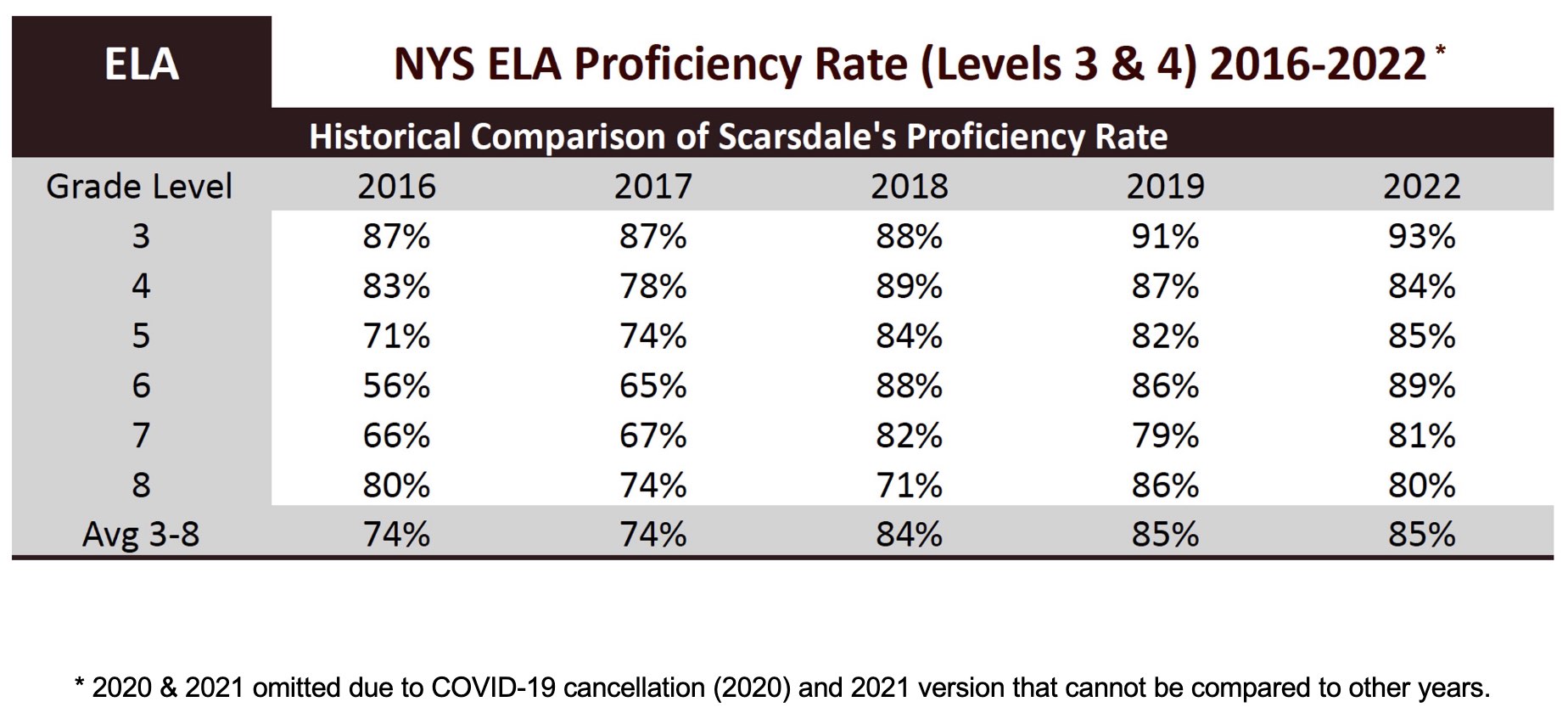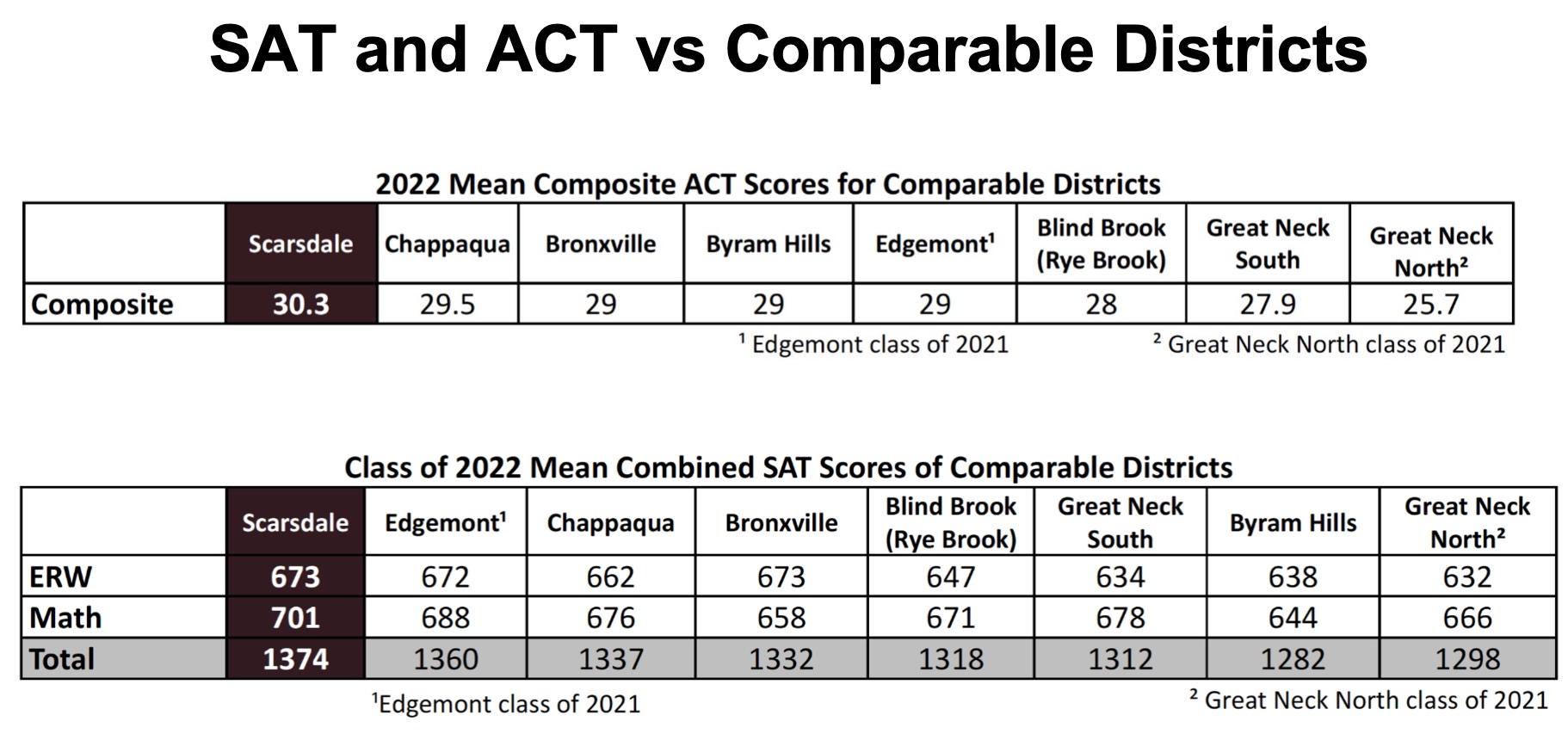Scarsdale Students Demonstrate High Proficiency on State-Wide Tests and College Entrance Exams
 At a time when the media is reporting educational gaps in learning due to the pandemic, students at Scarsdale Schools do not seem to have lost proficiency as demonstrated in statewide tests for elementary and middle schoolers and on the SAT’s, ACT’s and achievement tests for college-bound students.
At a time when the media is reporting educational gaps in learning due to the pandemic, students at Scarsdale Schools do not seem to have lost proficiency as demonstrated in statewide tests for elementary and middle schoolers and on the SAT’s, ACT’s and achievement tests for college-bound students.
Before previewing the results, Superintendent Drew Patrick cautioned that these tests only measure performance at a moment in time and do not reflect student’s experiences nor the value or merit of our schools. However he said, “We do pay attention to these measures against prior years and other communities.” He asked parents to “resist drawing sweeping conclusions from this data.”
Introducing the data, Assistant Superintendent Edgar McIntosh said, “Learning loss has been of great concern across the pandemic however Scarsdale continues to maintain high levels of achievement.” Again he warned, these results “represent only skills that can be assessed. Assessments were paused or amended during 2020-21, so we are comparing this data to 2019.”
About college admittance, Dean Oren Iosepovici will give a presentation about college admission at the BOE meeting 12/5.
The chart showed that nearly 100% of Scarsdale students go on to four year colleges. However, in 2022, 61% went onto the most competitive colleges which fell from 63% the prior year and 67% in 2020.
The mean SAT scores remained high at 673 on the English portion and 701 on the math, total mean scores compared positively to prior year and far exceed national values. Comparing Scarsdale’s ACT and SAT scores to comparable districts, Scarsdale scores were the highest among the eight comparable districts shown.
Scores on Advance Placement test were also impressive. In 2022, 94% of the 318 students taking 583 AP tests scored a 3,4 or 5.
Turning to elementary school student performance on the state ELA test, 85% of students in grades 3 to 7 scored in levels 3 and r of proficiency, which was on a par with 2018 and 2019.
On the math tests, 87% of Scarsdale students in grade 3-8 were proficient at levels 3 and 4, down one percentage point from 2019 and 2018.
The graphs show variation in these scores by elementary school, but again, McIntosh warned against drawing any conclusions about these small variances in performance.
During a question period from the Board, Jessica Resnick-Ault said, "At a time when a lot of districts have been dealing with falling scores we have seen some remarkable rises in some of these scores. What do you think accounts for that? McIntosh was not able to draw hard and fast conclusions, but said, "I believe there was a great deal of support for our students and structures built in to make sure we were attending to the content and skills that were essential in each grade." However, he did add, "communities that are the hardest hit are the ones with higher levels of poverty and less access."
Take a look at all the data here:
Click here to see the supporting data:
Commenting on the report, Mayra Kirkendall-Rodriguez said, "
Thank you for your time and efforts on the Education Report and supporting documents. Please tell us what are the quantitative and qualitative metrics that parents and taxpayers should refer to in order to establish if our children are receiving a world class education?
Page 5 of the report states that 60% of seniors are getting accepted to competitive colleges, a decline from 67% in 2020. Competitive in your report is the list of Barron’s top 100 universities and colleges. What about the other 40% in 2022? Where are they going? The school data that I have shows that in 2006, 82% of the senior class was accepted to the top 31 universities in the US. Last year, that figure was about 40%. So are the remaining 60% going to top colleges in the US? Institutes? Colleges or universities abroad? Why had that figure gone from 82% to 40%?
On pages 8-9 SAT and ACT scores are listed as the mean. Would it also be helpful to provide information as a median? How much does tutoring influence these scores?
On page 10 with the AP data, it shows that there has been a rise in students taking AP from 2016 to the present. Would it be helpful to include data from 2004 – 2005 before the decision was made to eliminate AP courses and go to AT? How many students took AP tests before that point and how does that compare to today?
On pages 14-19th, referring to state tests, Level 3, means proficient in state standards and level 4 means exceeding state standards. The data are lumped together in the presentation. Why not present the data in the presentation the way that it is in the supporting document on page 17 by each individual Levels 1-4?
Out of curiosity, why was Scarsdale 2021 data not shown in the report? While in 2021 some grades had fewer students take the tests, in some grades in 2021 more took them than in 2022. Aggregate Scarsdale Scores in 2022 have dropped significantly from peak proficiency years of 2009 and 2012 and also declined in comparison to 2021. Would you kindly provide detail as to causes for this?
What steps do you think are necessary to support students to excel state standards, which many argue are not sufficiently robust since there are many parts of NY where income and racial disparities lead to low level of resources unlike what we are so fortunate to have here. SMS 7th grade scores which now would be 8th graders had 38% exceling in ELA and 49% exceling in math standards? Do they need resources to help them transition to high school, since that is coming up rapidly? There were significant differences in the scores through the five elementary schools, especially a difference between Edgewood and Greenacres. Kindly give us insight as to why those differences exist and what resources are necessary so that everyone is at a level 4?
On world languages? What is the goal? Is it fluency? How is that being measured? If it is not fluency, then what are the objectives?
I look forward to hearing the questions that the BOE poses and what policies you might implement to support our students.